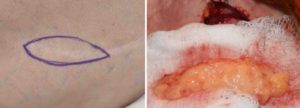Background: Chin implant augmentation is a common facial plastic surgery procedure that is not typically associated with wound healing problems. While the aesthetic outcome may be up for discussion in some cases, implants generally heal with a very low rate of infection or incisional wound healing problems. This is because the overlying soft tissue chin pad is reasonably thick and of normal quality which permits its tolerance for a synthetic material on a projecting bone area.
But when the soft tissue chin pad has been compromised and can not adequately stretch to accommodate the expansile forces of the implant, wound healing problems can occur. This is not a very common occurrence but can present in very short chins that have had implant placement through an external submental skin incision. With implant failures the submental skin crease becomes deeper and indented, which is reflective of a soft tissue deficiency between the skin and the bone. Trying to push out a scarred soft tissue chin pad with an implant challenges the thin tissues to heal.
When the soft tissue chin pad is inadequate, it needs to be first reconstructed before an implant can be placed. This requires fat grafting of which two types exist. Injectable fat grafting is very popular today but would likely take several attempts to develop adequate soft tissue thickness. In addition it can not successfully create a soft tissue release from the bone.
This produced an immediate correction of the inverted submental scar and restoration of a more normal soft tissue chin pad thickness.
The purpose of the dermal-fat graft to the chin was not for chin augmentation. Rather it was done as a first stage and preparatory approach to a secondary chin augmentation. With a thicker soft tissue cover and screw fixation of an implant, a more successful chin augmentation outcome is likely.



The purpose of the dermal-fat graft to the chin was not for chin augmentation. Rather it was done as a first stage and preparatory approach to a secondary chin augmentation. With a thicker soft tissue cover and screw fixation of an implant, a more successful chin augmentation outcome is likely.
Case Highlights:
1) Chin implants require an adequate soft tissue chin pad to adequately cover the volume expansion on the surface of the bone.
2) Repeat entries through a submental skin incision on a short chin results in loss of soft tissue thickness.
3) Secondary chin augmentation after multiple attempts will be benefit by adding a dermal-fat graft first before making another implant placement attempt.
Dr. Barry Eppley
Indianapolis, Indiana



